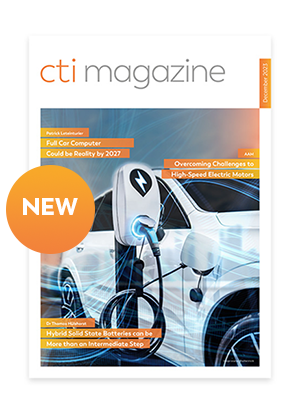
The only practical way for automobiles to meet strict CO2 reduction targets is through incremental powertrain electrification. But which concepts are most promising, and how do you get innovations into production fast? This is just one of the hot topics high calibre experts will be discussing at the 16th International CTI Symposium Berlin (4-7 December).
The quiet star: mild hybrids based on 48 V
Electric automobiles often grab the public’s attention, but have yet to break through. The most frequent objections are the high purchase price, and the lack of range and charging points.
48 V-based mild hybrids are different. Behind the scenes, this concept is gradually becoming the preferred candidate, particularly in terms of feasibility and cost-benefit ratio. The heart of the technology is a starter/ generator that can be added to existing powertrains with relatively little effort. This reduces the fuel consumption, and hence the CO2 emissions, of the internal combustion engine to a relative extent while offering drivers comfort features normally reserved for expensive high voltage technology. The existing 12 V system is integrated into the 48 V system, and is available in parallel.
A lot has happened since last year
48V boardnet-based hybridisation was an important issue at the CTI Symposia 2016, and the number of mild hybrids now available (or coming soon) testifies to its ongoing topicality. Participants in Berlin can look forward to all the latest developments, as well as interesting insights into what the future holds.
Have fun reducing CO2 emissions!
Mild hybrids perform better in a range of different driving scenarios. Recuperation has the biggest effect, while 48 V also makes the start/stop feature lightning fast and silky smooth. In ‘sail’ and ’coast’ modes (available depending on the system) the ICE sometimes shuts down completely. In ’boost’ mode, both the ICE and the electric motor accelerate the vehicle. Drivers feel the benefits immediately: the electric thrust enhances their driving enjoyment without higher consumption, and with lower emissions! That argument seems likely to make the system attractive – and acceptable – in all performance classes.
Electrifying innovations for drivers
Once you have a 48 V network, it makes sense to use it to run particularly power-hungry units and electrify further components. For example, electric AC compressors can run more efficiently, including when the internal combustion engine is off. A powerful electric compressor boosts power with no turbo lag. Other possibilities include suspension components such as electric roll stabilizers, heatable catalytic converters, heated windscreens and more besides. Here too, 48 V mild hybrids combine business and pleasure elegantly by reducing ICE emissions while enhancing comfort and driving enjoyment.
Interesting perspectives for the Connected Car
The term ‘smart phones on wheels’ is already being used with regard to in-car connectivity. With the aid of cloud-based information, the software on a 48V mild hybrid system can develop even smarter strategies based on current or anticipated driving scenarios. This will enable drivers to respond more proactively to traffic jams, traffic light sequences or speed limits, primarily in order to further reduce fuel consumption and CO2 emissions. Friedrich Graf, Director Development Continental AG, will provide examples in a lecture that examines the benefits of this type of ’connected energy Management’ and explains why it deserves the label ‘mild and smart’.
A discussion that remains fascinating
This is mainly due to the concept’s tremendous flexibility: it can be used in various different performance classes, and existing powertrain topologies can largely be retained. The positionings of electric motors from P0 to P4 permit different variants, each with their own specific advantages. In terms of transmissions manual shift, automatic shift or DCT versions are all feasible. The CTI Symposium Berlin will provide plenty of opportunities to dive deep into all the different alternatives.
So much for the theory. What about the practice?
‘Transmission Expo’ is a firm fixture at CTI Symposia. This time, 135 exhibitors from around the world will be presenting their latest developments in Berlin. We also invite you to take part in the CTI Test Drive at the ADAC Center of Driving Safety Berlin-Brandenburg. Don’t miss this opportunity to experience fascinating drive and transmission technologies live on the track!
Once again, the upcoming CTI Symposium Berlin offers the perfect platform for participants to share their knowledge and opinions about 48 V hybrid technology and a wealth of other interesting topics.
Lectures in the session on 48 V systems:
- Solutions for modular hybridisation of FWD DCTs; Dr Gereon Hellenbroich, Department Manager Design and CAE, Transmission Systems, FEV Europe GmbH, Germany
- Modular low cost 48 V P4 system for front- and 4-wheel-drive architectures: a customer plug-in hybrid; Dr Paul Kapus, Manager Gasoline Engine Development,
AVL List GmbH, Austria - 48 V advanced hybrids: mild and smart for better electrification; Friedrich Graf, Director Development, Powertrain Technology & Innovation, Continental AG, Germany
- Low voltage hybridisation: how to lower costs, enhance CO2 benefits and transmission impacts; Dr Olivier Coppin, Innovation and Scientific Development Director, Valeo, France
- AVL DynoShift II: low-cost modular powershifted transmission for complete electrification range; Vitaly Davydov, Design Engineer Transmission, AVL List GmbH, Austria
Find all information about the speeches at the 16th CTI Symposium in Berlin in our program:
